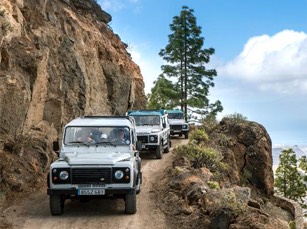Hersonissos – Heraklion – Knossos - Archanes
The famous palace of Knossos is situated on only five kilometers from Iraklion, a world known testimony to first civilization of Europe. It is the best way to start your visiting the island by spending at least two hours at the ruins of the largest Bronze Age archeological site on Crete, the ceremonial and political centre of the Minoan civilization and culture. Ten kilometers southwards is a lovely picturesque town of Archanes,found in the centre of an area full of archeological sites from the Minoan and Myceanean period.The town is famous for the grape fields and the traditional feast of the Archanes grape, taking place in mid-August.The town is close enough to Iraklion and the best way of arriving is by renting a car or motorbike, as it is the only comfortable way to visit the area and to enjoy both places.
Heraklion – Gortys – Phaistos - Agia Triada - Matala
This long one day trip is a definitely worthwhile experience for anyone wants to enjoy the archeological and historical monuments and the beautiful natural landscapes. Your journey starts off in Iraklion and you first get to see one of the most important cities of Crete, Gortys with the history of 6,000 years and one of the most extensive archeological sites in Greece.A visit to Gortys is limited to the part open to the public.You can leave your car in the car park and on your left is a part of the church St.Titus, you pass by and you cross the square with its old olive trees with their time-knotted trunks. They are the evidence of Gortys down the ages. Straight on is the evergreen plane tree of Gortys which was the shade at the wedding celebration of Zeus and Europa. The Pretorium was the seat and the residence of the Praetor, the Governor of the Roman province of Crete and Cyrenaica, when Gortys was the capital of Crete. Moving along you will meet the Grand Phaistos Palace,the second city founded by the Minoan civilization. The Palace corresponds to a city which arose in the fertile plain of the Messara in prehistoric times. It was built circa 2000BC and was destroyed in a strong earthquake, but very soon rebuilt. It was no longer the administrative center of the area butcontinued to be the religious and cult centre of the South Crete. There are also amazing natural landscapes and the beautiful view of the sacred mount Ida,having snow on the top most of the year. Leaving Phaistos you come to the valley of Ag.Triada. Through the history it became the administrative centre of South Crete. There you can see the ruins of a small Minoan palace Royal Villa, which was named after the village of Ag.Triada and was destroyed by the Turks. From here you can follow the road either to the beaches of Kokkinos Pyrgos or the new one going to Matala,10 kilometers from the ruins. Both places offer beautiful view of the Libyan sea. It is given the opportunity of visiting the caves sculpted into the cliffs. On the way back you can turn left or right around the village of Ag.Varvara which offers amazing views of the mountains and vineyards, and plenty of ancient uncovered settlements in the old villages Prinias, Assites and Ag.Myron.
Hersonissos - Lassithi Plateau - Malia
Lassithi Plateau is a wonderful cool and fertile area full of orange groves, vineyards, small towns and a very warm welcome. It is located at an altitude over 800 m and is the largest plateau in Crete. The Plateau is famous for its twenty four stone flour windmills dating back to 1800 but most of them are now ruined. Only three of them have been restored so far. Just before the Plateau is the Homosapien Museum which graphically illustrates the way the prehisctoric people lived in area. Lassithi is also where the cave of "Psychro", the cult place of Minoan Crete. The excavators identify the cave as the "Diktaian Cave" where Zeus was born. Mohos and Krasi are the most famous villages in Lassithi Plateau. Going up to Mohos you will enjoy a wonderful panoramic view of Hersonissos. Coming to the centre of Mohos, you can enjoy your coffee at one of tavernas there. The village preserves its traditional style and every Wednesday is arranged a traditional Cretan night. Follow the sign for Krasi and soon you will enter this pretty small village. At the square there is a huge Platanas tree, famous for its size and age. Possibly 1000 years old! It throws a big shadow over a small tavern where you can taste a famous Krasi grilled meat and greek coffee. As you leave the village, take the left sign and follow the sign for the Monastery Kera (Kardiotisa), which dates very deep in history and is famous for its Icon of the Holly Mother and the amazing story about it. On your back to the hotel, you can choose the road that goes over Malia. Malia is an area great of natural beauty. It is surrounded by olive groves and the slopes of Mt. Selena. The village of Malia is best known for its lively atmosphere, but it is as good for the young and older visitors. The beach is 3 km long with golden sand. Malia offers the best of both worlds since it consists of the old and the new town which are separated the main road. In the new part are situated many bars and restaurants. In the old town there are many narrow winding streets with many traditional taverns and coffee shops.
Hersonissos – Tylissos – Anogia – Axos - Garazo
Tylissos is the village ten kilometers from Iraklion to Rethymnon,the ancient Minoan peak sanctuary. You can see around grape yards and olive fields and stock farming of sheep, goats and chicken. The road heads toward mount Ida, and the villages Gonies and Anogia known for their handicrafts and embroideries, cheese and wine famous in the whole Crete. Following this direction you will come to the Mida Plateau and the Axos village with its Byzantyne churches and cemetery which is open to the tourists see-sighting. Just along the main road, 37 km from Rethymnon is the Garazo, and overlooks Milopotamos valley. It is famous for the production of citron. In May you can visit the Ceramic festival at the main square. By Venetian paving pass through the forest of Virgin Mary and reach the Kato Vrisi fountain.
Hersonissos – Rethymnon - Chania
The stroll in West part of the island including Rethymnon and Chania might ask from you a two days trip, but you will be able to admire it properly. Rethymnon is the city with a strong Venetian architectural influence in homes and citadel. You can visit the Archeological Museum situated at the fortress and Venetian Loggia. Enjoy long walks at the extraordinary Golden beach and have a meal in one of the many restaurants both at the centre and city suburbs. After Rethymnon , on a few kilometers from Georgioupoli is the freshwater Kournas Lake, the only one in Crete. It is in a beautiful landscape lying in a valley among the hills. It is the ideal place for an afternoon walk or a daytrip nearby. You can swim there or ride a pedalo. There are two springs on the southeast bank. The lake is fed by streams from the nearby mountains and hills. Continuing your trio to Chania you will see on your way the natural harbor of Souda and several small islands at its bay. They are surrounded by Venetian fortifications dominated with the Acrotiri Cape. It has some nice beaches which are visited mostly during the weekends by the inhabitants. A few monasteries became as well popular by the tourists, as the Agia triada and Katholiko. Finally, at the end of the trip is Fascinating Chania with its strong Venetian architectural influence and wide streets, gardens, museums, citadel, churches which underline its historical richness and heritage. Come down to the old port area to enjoy a great sea food and traditional meals in oone of the many restaurants.
 Pick Up and Drop Off at Locations all over Crete
Pick Up and Drop Off at Locations all over Crete

 Rent a Car in Crete with Royal Car Rental Private Transfers Search for Popular Locations all over Crete Deliveries upon request to all major locations and villages.
Rent a Car in Crete with Royal Car Rental Private Transfers Search for Popular Locations all over Crete Deliveries upon request to all major locations and villages. Rent a Car in Crete with Royal Car Rental Excursions in Crete Search for Popular Locations all over Crete Deliveries upon request to all major locations and villages.
Rent a Car in Crete with Royal Car Rental Excursions in Crete Search for Popular Locations all over Crete Deliveries upon request to all major locations and villages.















